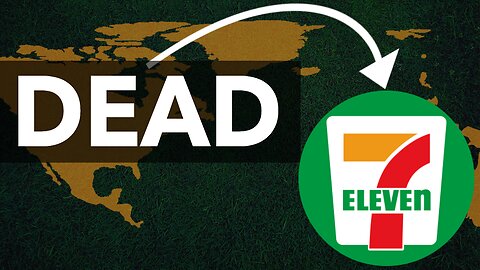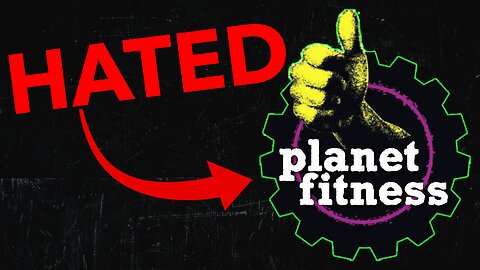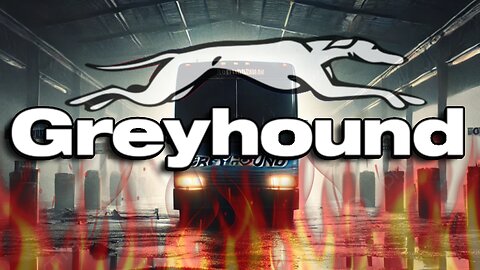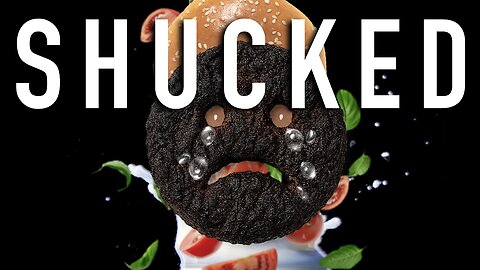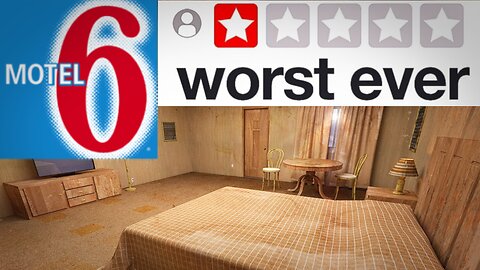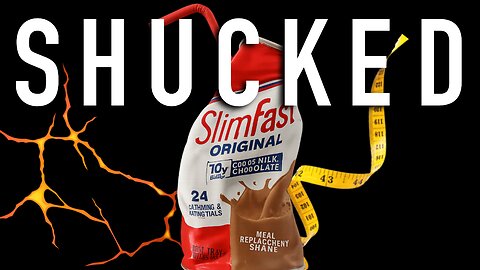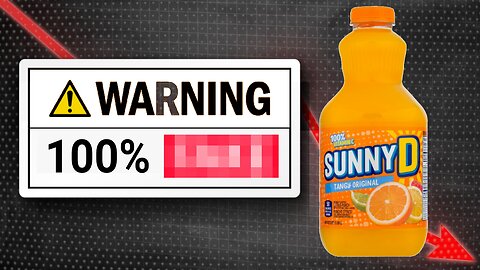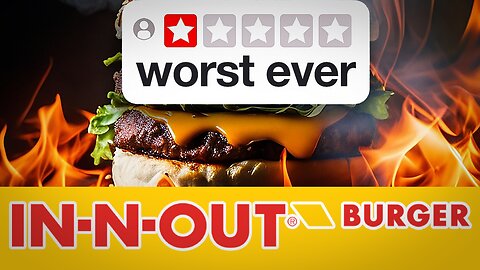
Corporate Mistakes That Destroyed Brands
15 videos
Updated 6 months ago
Explore the untold stories of major brands that lost their edge. Real insights into corporate missteps and failures.
-
The In-N-Out Disaster: Overhyped and Overrated?
 Mini Money Docs™Why is In-N-Out Burger So BAD despite all the buzz and hype? Once celebrated for its quality and consistency, is now facing growing dissatisfaction despite the buzz and hype. Customers who once praised the fast-food chain for its fresh ingredients and delicious burgers have recently voiced complaints about a noticeable decline in food quality. In-N-Out's once-stellar reputation is being tarnished by reports of inconsistent food preparation, overcooked burgers, tasteless toppings, and subpar fries. While these complaints were initially linked to challenges in California, they have since spread to other states, showing that the issue is more widespread. The fast-food giant, founded in 1948, was built on a commitment to quality and fresh ingredients. In-N-Out’s dedication to banning microwaves, freezers, and heat lamps in its kitchens earned it a loyal following for decades. However, the rapid expansion outside California, especially in states like Texas, Colorado, and Oregon, has created logistical challenges. These challenges, combined with economic pressures, rising crime rates in California, and increasing menu prices, have all contributed to the growing complaints about the decline in food quality. Despite these issues, In-N-Out remains focused on addressing customer concerns and restoring its reputation. The company is doubling down on its founding principles, including daily fresh ingredient deliveries and reinforcing strict food preparation protocols. The fast-food chain continues to rely on its limited menu and location strategy to keep costs low and maintain a competitive edge. While In-N-Out faces significant challenges, its ability to adapt and stay true to its core values positions it for a potential recovery. In-N-Out’s quality issues, declining food standards, and operational struggles highlight the challenges faced by a brand that was once seen as the pinnacle of fast-food excellence. The company’s efforts to resolve customer dissatisfaction and return to its original high standards are crucial for its future success. By focusing on its legacy of quality, consistency, and simplicity, In-N-Out aims to regain its status as a leader in the fast-food industry. 00:00 – In-N-Out Burger Quality Decline 01:07 – The History of In-N-Out Burger 02:04 – In-N-Out Burger Food Quality Issues 02:37 – Why Did In-N-Out Burger Decline in Quality? 03:23 – Problems in California 04:10 – Rise in Minimum Wage 05:24 – In-N-Out’s Response9 views
Mini Money Docs™Why is In-N-Out Burger So BAD despite all the buzz and hype? Once celebrated for its quality and consistency, is now facing growing dissatisfaction despite the buzz and hype. Customers who once praised the fast-food chain for its fresh ingredients and delicious burgers have recently voiced complaints about a noticeable decline in food quality. In-N-Out's once-stellar reputation is being tarnished by reports of inconsistent food preparation, overcooked burgers, tasteless toppings, and subpar fries. While these complaints were initially linked to challenges in California, they have since spread to other states, showing that the issue is more widespread. The fast-food giant, founded in 1948, was built on a commitment to quality and fresh ingredients. In-N-Out’s dedication to banning microwaves, freezers, and heat lamps in its kitchens earned it a loyal following for decades. However, the rapid expansion outside California, especially in states like Texas, Colorado, and Oregon, has created logistical challenges. These challenges, combined with economic pressures, rising crime rates in California, and increasing menu prices, have all contributed to the growing complaints about the decline in food quality. Despite these issues, In-N-Out remains focused on addressing customer concerns and restoring its reputation. The company is doubling down on its founding principles, including daily fresh ingredient deliveries and reinforcing strict food preparation protocols. The fast-food chain continues to rely on its limited menu and location strategy to keep costs low and maintain a competitive edge. While In-N-Out faces significant challenges, its ability to adapt and stay true to its core values positions it for a potential recovery. In-N-Out’s quality issues, declining food standards, and operational struggles highlight the challenges faced by a brand that was once seen as the pinnacle of fast-food excellence. The company’s efforts to resolve customer dissatisfaction and return to its original high standards are crucial for its future success. By focusing on its legacy of quality, consistency, and simplicity, In-N-Out aims to regain its status as a leader in the fast-food industry. 00:00 – In-N-Out Burger Quality Decline 01:07 – The History of In-N-Out Burger 02:04 – In-N-Out Burger Food Quality Issues 02:37 – Why Did In-N-Out Burger Decline in Quality? 03:23 – Problems in California 04:10 – Rise in Minimum Wage 05:24 – In-N-Out’s Response9 views -
How America Ruined 7-Eleven
 Mini Money Docs™7-Eleven is failing in North America, shutting down over 400 stores and struggling to survive in the U.S. despite its massive success in Asia. This video explores why 7-Eleven is closing stores and the factors behind its downfall in the U.S., including the stark food culture differences between Asian 7-Eleven and American 7-Eleven. While 7-Eleven dominates Asia, particularly in Japan, where it has become a beloved destination for fresh, affordable meals, it has not been able to replicate this success in the U.S. We delve into the reasons behind this, including the 7-Eleven rebranding challenges and the difficulties the brand faces in adapting its business model to meet American consumer expectations. This business failure explained examines how 7-Eleven went from a thriving global brand to a company facing major struggles. We’ll also look at how 7-Eleven dominated Asia but failed in America, focusing on its attempt to introduce fresh food options in U.S. stores and the economic challenges that come with changing its established model. In this business case study of 7-Eleven’s downfall, we explore why 7-Eleven struggles in the U.S., and why it can’t seem to replicate its 7-Eleven Japan success story. Is the American market too set in its ways for a rebranding of 7-Eleven to succeed? Tune in to discover the reasons behind the downfall of 7-Eleven in the U.S. and whether it can reinvent itself in the face of 7-Eleven rebranding hurdles. 00:00 – 7-Eleven Failing in North America 00:38 – The Rise of 7-Eleven 01:22 – First 7-Eleven in Japan (Ito-Yokado) 01:53 – 7-Eleven Viral on Social Media 02:08 – Ed Sheeran 7-Eleven TikTok 02:19 – Asian Success vs American Failure 02:19 – 7-Eleven’s Downfall in the U.S. 04:17 - 7-Eleven’s Success in Asia 05:17 - Why 7-Eleven is Successful in Asia 06:21 - American Food Culture 06:57 - 7-Eleven More Expensive in the US 07:51 - What can 7-Eleven do? 08:12 - Rebranding Challenges16 views 1 comment
Mini Money Docs™7-Eleven is failing in North America, shutting down over 400 stores and struggling to survive in the U.S. despite its massive success in Asia. This video explores why 7-Eleven is closing stores and the factors behind its downfall in the U.S., including the stark food culture differences between Asian 7-Eleven and American 7-Eleven. While 7-Eleven dominates Asia, particularly in Japan, where it has become a beloved destination for fresh, affordable meals, it has not been able to replicate this success in the U.S. We delve into the reasons behind this, including the 7-Eleven rebranding challenges and the difficulties the brand faces in adapting its business model to meet American consumer expectations. This business failure explained examines how 7-Eleven went from a thriving global brand to a company facing major struggles. We’ll also look at how 7-Eleven dominated Asia but failed in America, focusing on its attempt to introduce fresh food options in U.S. stores and the economic challenges that come with changing its established model. In this business case study of 7-Eleven’s downfall, we explore why 7-Eleven struggles in the U.S., and why it can’t seem to replicate its 7-Eleven Japan success story. Is the American market too set in its ways for a rebranding of 7-Eleven to succeed? Tune in to discover the reasons behind the downfall of 7-Eleven in the U.S. and whether it can reinvent itself in the face of 7-Eleven rebranding hurdles. 00:00 – 7-Eleven Failing in North America 00:38 – The Rise of 7-Eleven 01:22 – First 7-Eleven in Japan (Ito-Yokado) 01:53 – 7-Eleven Viral on Social Media 02:08 – Ed Sheeran 7-Eleven TikTok 02:19 – Asian Success vs American Failure 02:19 – 7-Eleven’s Downfall in the U.S. 04:17 - 7-Eleven’s Success in Asia 05:17 - Why 7-Eleven is Successful in Asia 06:21 - American Food Culture 06:57 - 7-Eleven More Expensive in the US 07:51 - What can 7-Eleven do? 08:12 - Rebranding Challenges16 views 1 comment -
Everyone MOCKED This Gym… Now It's MORE SUCCESSFUL Than Ever
 Mini Money Docs™Planet Fitness just set new all-time highs in earnings and stock performance but it's still the MOST HATED gym. HOW? Well beneath the welcoming branding lies a business model that keeps people paying without necessarily helping them achieve their fitness goals. This is why many see it as the Planet Fitness membership trap—a system designed to attract beginners but subtly discourage progress, leading to an endless cycle of paying without real results. Why People Stay at Planet Fitness Despite its drawbacks, people continue to hold onto their memberships. The ultra-low $10 monthly fee makes it seem like a no-brainer to keep, even if they barely use it. This low-cost commitment means canceling feels unnecessary, even when members stop going. The gym also offers perks like free pizza nights and bagels, reinforcing a comfortable, social environment rather than one focused on serious fitness. Why people stay at Planet Fitness often comes down to convenience and cost rather than effectiveness. Planet Fitness Fail: Why the Gym Model Doesn’t Work Many fitness enthusiasts and professionals criticize Planet Fitness for promoting unrealistic fitness goals while discouraging traditional bodybuilding and strength training. The infamous Lunk Alarm—which sounds off when someone lifts too loudly or grunts—alienates serious gym-goers. Instead of fostering real progress, it caters to casual users who may never see significant improvements. This is why Planet Fitness doesn’t work for people serious about their fitness journeys. Is Planet Fitness Worth It? The Hidden Downsides On the surface, Planet Fitness offers an unbeatable deal. But is it truly worth it? For those seeking true progress, the answer is often no. The gym lacks essential equipment like squat racks and heavy free weights, limiting strength training options. Additionally, the business relies on signing up large numbers of people who rarely use their memberships, ensuring packed gyms in January but near-empty floors by March. Is Planet Fitness worth it? That depends on whether you want real fitness results or just a cheap place to say you have a gym membership. Planet Fitness Addiction Explained: Why People Keep Paying One of the biggest criticisms of Planet Fitness is its ability to hook people into a gym membership they barely use. This isn’t accidental. The ultra-affordable price means members don’t feel financial pressure to go, making it easier to ignore their fitness goals while continuing to pay. Over time, this creates a psychological effect similar to a subscription service—people feel they should keep it "just in case." Planet Fitness Membership Cancellation Issues Trying to cancel a Planet Fitness membership is notoriously difficult. Many locations require members to visit in person to cancel, often resulting in aggressive sales pitches to stay. Some have reported continued charges even after canceling, leading to frustration and accusations of Planet Fitness scam tactics. The Most Hated Gym? Why Planet Fitness Faces Backlash Over time, Planet Fitness has earned a reputation as the most hated gym in the industry. Serious fitness communities criticize its policies, lack of proper equipment, and deceptive business practices. While it remains a popular choice for beginners, those who want real progress often leave for more serious gyms. Why Planet Fitness is the most hated gym stems from its focus on keeping people comfortable rather than truly fit. 00:00 Planet Fitness is worse than you think 01:06 How Planet Fitness became successful 01:34 Fear-based advertising tactics 02:15 Record-breaking stock prices despite hate 02:25 How Planet Fitness differs from other gyms 02:35 Targeting beginners over serious gym-goers 02:45 The restrictions on serious workouts 03:03 Banning traditional exercises 03:24 The infamous lunk alarm 03:36 Judgment-free unless you’re too fit 04:13 Clothing and accessory bans 04:22 The water bottle controversy 04:37 The absurdity of its gym rules 05:01 Undermining nutrition and healthy habits 05:18 Pizza Mondays and Bagel Tuesdays 05:29 The hypothesis behind free junk food 05:39 Lack of nutritional guidance 05:58 Why Planet Fitness doesn’t want fit members 06:18 Why thousands try to leave every year 06:38 Planet Fitness makes cancelling difficult 06:57 No online or phone cancellations 07:11 Strict cancellation time limits 07:30 Why Planet Fitness avoids credit card payments 08:05 The endless cycle of bank fees 08:52 Ignoring cancellation requests 09:24 North Dakota Attorney General complaint 09:56 The shocking tanning bed incident 10:21 Why Planet Fitness remains successful 10:31 The Biggest Loser partnership 10:53 Cross-promotions with weight-loss shows 11:08 Strategic event sponsorships 11:19 The power of ultra-low pricing 11:49 Planet Fitness is more successful than ever 12:03 The adult daycare for cardio addicts 12:47 Why Planet Fitness is so successful32 views
Mini Money Docs™Planet Fitness just set new all-time highs in earnings and stock performance but it's still the MOST HATED gym. HOW? Well beneath the welcoming branding lies a business model that keeps people paying without necessarily helping them achieve their fitness goals. This is why many see it as the Planet Fitness membership trap—a system designed to attract beginners but subtly discourage progress, leading to an endless cycle of paying without real results. Why People Stay at Planet Fitness Despite its drawbacks, people continue to hold onto their memberships. The ultra-low $10 monthly fee makes it seem like a no-brainer to keep, even if they barely use it. This low-cost commitment means canceling feels unnecessary, even when members stop going. The gym also offers perks like free pizza nights and bagels, reinforcing a comfortable, social environment rather than one focused on serious fitness. Why people stay at Planet Fitness often comes down to convenience and cost rather than effectiveness. Planet Fitness Fail: Why the Gym Model Doesn’t Work Many fitness enthusiasts and professionals criticize Planet Fitness for promoting unrealistic fitness goals while discouraging traditional bodybuilding and strength training. The infamous Lunk Alarm—which sounds off when someone lifts too loudly or grunts—alienates serious gym-goers. Instead of fostering real progress, it caters to casual users who may never see significant improvements. This is why Planet Fitness doesn’t work for people serious about their fitness journeys. Is Planet Fitness Worth It? The Hidden Downsides On the surface, Planet Fitness offers an unbeatable deal. But is it truly worth it? For those seeking true progress, the answer is often no. The gym lacks essential equipment like squat racks and heavy free weights, limiting strength training options. Additionally, the business relies on signing up large numbers of people who rarely use their memberships, ensuring packed gyms in January but near-empty floors by March. Is Planet Fitness worth it? That depends on whether you want real fitness results or just a cheap place to say you have a gym membership. Planet Fitness Addiction Explained: Why People Keep Paying One of the biggest criticisms of Planet Fitness is its ability to hook people into a gym membership they barely use. This isn’t accidental. The ultra-affordable price means members don’t feel financial pressure to go, making it easier to ignore their fitness goals while continuing to pay. Over time, this creates a psychological effect similar to a subscription service—people feel they should keep it "just in case." Planet Fitness Membership Cancellation Issues Trying to cancel a Planet Fitness membership is notoriously difficult. Many locations require members to visit in person to cancel, often resulting in aggressive sales pitches to stay. Some have reported continued charges even after canceling, leading to frustration and accusations of Planet Fitness scam tactics. The Most Hated Gym? Why Planet Fitness Faces Backlash Over time, Planet Fitness has earned a reputation as the most hated gym in the industry. Serious fitness communities criticize its policies, lack of proper equipment, and deceptive business practices. While it remains a popular choice for beginners, those who want real progress often leave for more serious gyms. Why Planet Fitness is the most hated gym stems from its focus on keeping people comfortable rather than truly fit. 00:00 Planet Fitness is worse than you think 01:06 How Planet Fitness became successful 01:34 Fear-based advertising tactics 02:15 Record-breaking stock prices despite hate 02:25 How Planet Fitness differs from other gyms 02:35 Targeting beginners over serious gym-goers 02:45 The restrictions on serious workouts 03:03 Banning traditional exercises 03:24 The infamous lunk alarm 03:36 Judgment-free unless you’re too fit 04:13 Clothing and accessory bans 04:22 The water bottle controversy 04:37 The absurdity of its gym rules 05:01 Undermining nutrition and healthy habits 05:18 Pizza Mondays and Bagel Tuesdays 05:29 The hypothesis behind free junk food 05:39 Lack of nutritional guidance 05:58 Why Planet Fitness doesn’t want fit members 06:18 Why thousands try to leave every year 06:38 Planet Fitness makes cancelling difficult 06:57 No online or phone cancellations 07:11 Strict cancellation time limits 07:30 Why Planet Fitness avoids credit card payments 08:05 The endless cycle of bank fees 08:52 Ignoring cancellation requests 09:24 North Dakota Attorney General complaint 09:56 The shocking tanning bed incident 10:21 Why Planet Fitness remains successful 10:31 The Biggest Loser partnership 10:53 Cross-promotions with weight-loss shows 11:08 Strategic event sponsorships 11:19 The power of ultra-low pricing 11:49 Planet Fitness is more successful than ever 12:03 The adult daycare for cardio addicts 12:47 Why Planet Fitness is so successful32 views -
How Greyhound Destroyed Itself
 Mini Money Docs™Greyhound's is going through a slow destruction and it's turning into a national transport nightmare. And its downfall threatens to leave millions of passengers stranded. Once a reliable and affordable option for low-income and vulnerable travelers, the bus network is crumbling due to financial struggles, rising crime, and a failing infrastructure. With rapid station closures, service cuts, and declining reliability, the situation is more dire than ever. Founded in 1914 in Hibbing, Minnesota, Greyhound quickly expanded to become America’s largest intercity bus network, connecting even the most remote towns. At its peak, it had nearly 4,750 stations, providing an essential service to those without other travel options. However, the rise of the interstate highway system, increased car ownership, and the expansion of air travel led to a sharp decline in ridership. Between 1960 and 2006, Greyhound’s passenger numbers dropped by over 70%, from 140 million to just 40 million. The final blow came with the rise of the Chinatown bus model in the 1990s. Competitors like MegaBus and BoltBus bypassed costly terminals, operating curbside routes between major cities, drastically reducing overhead costs. These newer companies offered modern buses, free Wi-Fi, and lower fares, leaving Greyhound struggling with outdated vehicles and expensive terminal maintenance. Unable to compete, Greyhound hemorrhaged passengers and revenue. In 2021, Greyhound was acquired by the German company FlixBus, which aimed to modernize the brand by shifting to an app-based model and reducing reliance on physical bus terminals. This transition has been disastrous for many passengers who lack smartphones or credit cards, disproportionately affecting elderly and low-income travelers. A DePaul University study found that 75% of U.S. coach travelers earn less than $40,000 per year, and 25% would be unable to make their trips without bus service. Greyhound’s bus terminals were once architectural landmarks, built in the iconic Art Deco style and serving as vital community hubs. They offered 24-hour facilities, providing safe places to wait, access to bathrooms, and affordable food options. However, these stations became costly to maintain, attracting crime and homelessness, further discouraging investment. As a result, FlixBus chose not to acquire Greyhound’s real estate, leading to the rapid sell-off of terminals to private developers and hedge funds. The consequences of station closures have been devastating. Many passengers now board buses from poorly lit parking lots, exposed to harsh weather with no access to basic amenities. Long layovers and missed connections have become common, making travel an exhausting and unsafe experience. The loss of designated bus terminals has also led to increased street congestion and safety concerns, forcing cities to reconsider curbside pickup regulations. Unlike trains and city transit systems, Greyhound receives almost no government subsidies, despite serving as a crucial lifeline for low-income Americans. While public transit is funded at federal, state, and local levels, long-distance bus travel is treated as a private enterprise, leaving Greyhound and its passengers with little support. As terminals close and services decline, the lack of investment in intercity coach travel has become an undeniable national issue. Greyhound’s collapse could have irreversible consequences for American transportation. Without intervention, the U.S. risks losing the only affordable travel option available to millions. The question remains: Will policymakers step in before it’s too late, or will Greyhound become yet another casualty of America’s failing infrastructure? 0:00 - Greyhound's decline and crisis 1:08 - Greyhound’s history and rise 1:41 - Impact of the interstate system 1:54 - Greyhound’s declining passenger numbers 2:17 - Rise of Chinatown buses and Megabus 3:31 - Greyhound’s Old buses and poor onboard conditions 3:58 - State of Greyhound’s onboard bathroom / toilet 4:09 - Competition have better and more modern coaches 4:33 - The problem with the new competition 5:18 - FlixBus acquires Greyhound in 2021 5:25 - Shift to Uber style app-based service 5:57 - Why the app based move was a disaster 6:13 - DePaul study on coach passengers 6:26 - The new app based model & customer experience 6:44 - Customer service issues 7:16 - Greyhound's architectural legacy 7:31 - Evansville Greyhound Station 7:53 - Importance of Greyhound terminals 8:17 - Bus terminals: the flaw in the business model 8:45 - Homelessness, crime and security costs 9:07 - Greyhound's most valuable assets 9:21 - Greyhound Terminals sold-off 9:34 - Mixed reactions to closures 9:51 - Inaccessible replacement stops 10:12 - The harsh reality of curbside stops 11:09 - Serious consequences of closures 11:40 - Cities struggle to regulate curbside crowds 12:02 - The government’s role in the crisis 12:42 - Greyhound’s impressive fight for survival28 views
Mini Money Docs™Greyhound's is going through a slow destruction and it's turning into a national transport nightmare. And its downfall threatens to leave millions of passengers stranded. Once a reliable and affordable option for low-income and vulnerable travelers, the bus network is crumbling due to financial struggles, rising crime, and a failing infrastructure. With rapid station closures, service cuts, and declining reliability, the situation is more dire than ever. Founded in 1914 in Hibbing, Minnesota, Greyhound quickly expanded to become America’s largest intercity bus network, connecting even the most remote towns. At its peak, it had nearly 4,750 stations, providing an essential service to those without other travel options. However, the rise of the interstate highway system, increased car ownership, and the expansion of air travel led to a sharp decline in ridership. Between 1960 and 2006, Greyhound’s passenger numbers dropped by over 70%, from 140 million to just 40 million. The final blow came with the rise of the Chinatown bus model in the 1990s. Competitors like MegaBus and BoltBus bypassed costly terminals, operating curbside routes between major cities, drastically reducing overhead costs. These newer companies offered modern buses, free Wi-Fi, and lower fares, leaving Greyhound struggling with outdated vehicles and expensive terminal maintenance. Unable to compete, Greyhound hemorrhaged passengers and revenue. In 2021, Greyhound was acquired by the German company FlixBus, which aimed to modernize the brand by shifting to an app-based model and reducing reliance on physical bus terminals. This transition has been disastrous for many passengers who lack smartphones or credit cards, disproportionately affecting elderly and low-income travelers. A DePaul University study found that 75% of U.S. coach travelers earn less than $40,000 per year, and 25% would be unable to make their trips without bus service. Greyhound’s bus terminals were once architectural landmarks, built in the iconic Art Deco style and serving as vital community hubs. They offered 24-hour facilities, providing safe places to wait, access to bathrooms, and affordable food options. However, these stations became costly to maintain, attracting crime and homelessness, further discouraging investment. As a result, FlixBus chose not to acquire Greyhound’s real estate, leading to the rapid sell-off of terminals to private developers and hedge funds. The consequences of station closures have been devastating. Many passengers now board buses from poorly lit parking lots, exposed to harsh weather with no access to basic amenities. Long layovers and missed connections have become common, making travel an exhausting and unsafe experience. The loss of designated bus terminals has also led to increased street congestion and safety concerns, forcing cities to reconsider curbside pickup regulations. Unlike trains and city transit systems, Greyhound receives almost no government subsidies, despite serving as a crucial lifeline for low-income Americans. While public transit is funded at federal, state, and local levels, long-distance bus travel is treated as a private enterprise, leaving Greyhound and its passengers with little support. As terminals close and services decline, the lack of investment in intercity coach travel has become an undeniable national issue. Greyhound’s collapse could have irreversible consequences for American transportation. Without intervention, the U.S. risks losing the only affordable travel option available to millions. The question remains: Will policymakers step in before it’s too late, or will Greyhound become yet another casualty of America’s failing infrastructure? 0:00 - Greyhound's decline and crisis 1:08 - Greyhound’s history and rise 1:41 - Impact of the interstate system 1:54 - Greyhound’s declining passenger numbers 2:17 - Rise of Chinatown buses and Megabus 3:31 - Greyhound’s Old buses and poor onboard conditions 3:58 - State of Greyhound’s onboard bathroom / toilet 4:09 - Competition have better and more modern coaches 4:33 - The problem with the new competition 5:18 - FlixBus acquires Greyhound in 2021 5:25 - Shift to Uber style app-based service 5:57 - Why the app based move was a disaster 6:13 - DePaul study on coach passengers 6:26 - The new app based model & customer experience 6:44 - Customer service issues 7:16 - Greyhound's architectural legacy 7:31 - Evansville Greyhound Station 7:53 - Importance of Greyhound terminals 8:17 - Bus terminals: the flaw in the business model 8:45 - Homelessness, crime and security costs 9:07 - Greyhound's most valuable assets 9:21 - Greyhound Terminals sold-off 9:34 - Mixed reactions to closures 9:51 - Inaccessible replacement stops 10:12 - The harsh reality of curbside stops 11:09 - Serious consequences of closures 11:40 - Cities struggle to regulate curbside crowds 12:02 - The government’s role in the crisis 12:42 - Greyhound’s impressive fight for survival28 views -
How Steak n Shake Destroyed Itself and Became Its Own Worst Enemy
 Mini Money Docs™Steak 'n Shake: The Rise, Fall, and Shocking Truth Behind Its Decline. This restaurant chain was once one of America’s most beloved fast-food chains, known for its famous Steakburgers and hand-dipped milkshakes. But today, it is a shadow of its former self, with declining sales, lawsuits, franchisee dissatisfaction, and a struggling business model. While many assume the pandemic was to blame, the truth is that Steak 'n Shake’s problems started long before 2020. In this video, we dive deep into the rise and fall of Steak 'n Shake, uncovering the bad decisions, mismanagement, and financial struggles that led to its downfall. Founded in 1934, Steak 'n Shake was built on the promise of quality, with founder Gus Belt grinding steak into burgers right in front of customers. The restaurant quickly expanded, becoming a staple in American fast food. But everything changed in 2008, when billionaire Sardar Biglari took over the company through Biglari Holdings. Initially, his aggressive leadership turned the brand around, but over time, his cost-cutting measures and controversial decisions pushed the company into turmoil. From removing cherries on milkshakes to implementing a disastrous quick-service model, these changes alienated customers and franchisees alike. Franchisees, once hopeful for profitable partnerships, soon found themselves trapped in restrictive contracts, overcharged for supplies, and unable to raise their own prices. Many filed lawsuits against the company, painting a grim picture of financial losses and corporate negligence. The issues extended to corporate managers as well, with Steak 'n Shake facing multi-million dollar lawsuits for unpaid overtime and unfair labor practices. Another major problem was the shift away from a traditional dine-in experience. Steak 'n Shake was known for its sit-down service for 78 years, but in an attempt to cut costs, the company rushed into a quick-service model with self-service kiosks and drive-thrus. Customers were unimpressed, complaining about poor food quality, long wait times, and uninviting dining areas. What was supposed to modernize the brand ended up driving away loyal customers. Steak 'n Shake’s menu also posed challenges. With no real healthy options and extreme calorie-loaded meals, it struggled to appeal to modern consumers who sought balance between indulgence and nutrition. The restaurant was even named in the Center for Science in the Public Interest’s Extreme Eating Awards for its massive 7x7 Steakburger and high-calorie milkshakes, which contributed to its perception as an outdated fast-food chain. Today, Steak 'n Shake is battling against declining sales, increasing debt, and a tarnished brand reputation. #SteaknShake #FastFoodFail #BusinessCollapse #FranchiseProblems #FoodIndustry #RestaurantFailure #BiglariHoldings #fastfoodhistory 00:00 The pandemic wasn’t to blame 00:51 Stake n Shake’s early success 01:16 2008: Crises and Biglari takeover 01:43 From turnaround to disaster 01:55 Sadar Biglari: A controversial leader 02:07 Biglari CEO pay controversy 02:46 The double-edged sword of bold decisions 02:57 How cost-cutting backfired 03:24 The infamous removal of the cherries 03:40 Disastrous move to quick-service 04:30 Why the new self-service model failed 04:56 The nightmare for Steak 'n Shake franchisees 05:31 The franchisee lawsuit that exposed everything 06:33 The managers’ lawsuit and wage violations 07:28 A critical flaw: The menu problem 07:45 Unhealthy choices alienating modern customers 08:03 The 7x7 Steakburger controversy 08:42 No real healthy options to attract new customers 09:11 Steak 'n Shake’s battle for survival 09:21 The cycle of debt and declining sales21 views 1 comment
Mini Money Docs™Steak 'n Shake: The Rise, Fall, and Shocking Truth Behind Its Decline. This restaurant chain was once one of America’s most beloved fast-food chains, known for its famous Steakburgers and hand-dipped milkshakes. But today, it is a shadow of its former self, with declining sales, lawsuits, franchisee dissatisfaction, and a struggling business model. While many assume the pandemic was to blame, the truth is that Steak 'n Shake’s problems started long before 2020. In this video, we dive deep into the rise and fall of Steak 'n Shake, uncovering the bad decisions, mismanagement, and financial struggles that led to its downfall. Founded in 1934, Steak 'n Shake was built on the promise of quality, with founder Gus Belt grinding steak into burgers right in front of customers. The restaurant quickly expanded, becoming a staple in American fast food. But everything changed in 2008, when billionaire Sardar Biglari took over the company through Biglari Holdings. Initially, his aggressive leadership turned the brand around, but over time, his cost-cutting measures and controversial decisions pushed the company into turmoil. From removing cherries on milkshakes to implementing a disastrous quick-service model, these changes alienated customers and franchisees alike. Franchisees, once hopeful for profitable partnerships, soon found themselves trapped in restrictive contracts, overcharged for supplies, and unable to raise their own prices. Many filed lawsuits against the company, painting a grim picture of financial losses and corporate negligence. The issues extended to corporate managers as well, with Steak 'n Shake facing multi-million dollar lawsuits for unpaid overtime and unfair labor practices. Another major problem was the shift away from a traditional dine-in experience. Steak 'n Shake was known for its sit-down service for 78 years, but in an attempt to cut costs, the company rushed into a quick-service model with self-service kiosks and drive-thrus. Customers were unimpressed, complaining about poor food quality, long wait times, and uninviting dining areas. What was supposed to modernize the brand ended up driving away loyal customers. Steak 'n Shake’s menu also posed challenges. With no real healthy options and extreme calorie-loaded meals, it struggled to appeal to modern consumers who sought balance between indulgence and nutrition. The restaurant was even named in the Center for Science in the Public Interest’s Extreme Eating Awards for its massive 7x7 Steakburger and high-calorie milkshakes, which contributed to its perception as an outdated fast-food chain. Today, Steak 'n Shake is battling against declining sales, increasing debt, and a tarnished brand reputation. #SteaknShake #FastFoodFail #BusinessCollapse #FranchiseProblems #FoodIndustry #RestaurantFailure #BiglariHoldings #fastfoodhistory 00:00 The pandemic wasn’t to blame 00:51 Stake n Shake’s early success 01:16 2008: Crises and Biglari takeover 01:43 From turnaround to disaster 01:55 Sadar Biglari: A controversial leader 02:07 Biglari CEO pay controversy 02:46 The double-edged sword of bold decisions 02:57 How cost-cutting backfired 03:24 The infamous removal of the cherries 03:40 Disastrous move to quick-service 04:30 Why the new self-service model failed 04:56 The nightmare for Steak 'n Shake franchisees 05:31 The franchisee lawsuit that exposed everything 06:33 The managers’ lawsuit and wage violations 07:28 A critical flaw: The menu problem 07:45 Unhealthy choices alienating modern customers 08:03 The 7x7 Steakburger controversy 08:42 No real healthy options to attract new customers 09:11 Steak 'n Shake’s battle for survival 09:21 The cycle of debt and declining sales21 views 1 comment -
Motel 6 Was Once An American Icon. Now It’s A Nightmare.
 Mini Money Docs™It was a $6 a night hotel that America once loved and now HATES! It revolutionized budget travel with its promise of affordable, no-frills lodging, but over the years, the brand has faced significant challenges. From its early days of offering $6 rooms to becoming one of the most criticized motel chains in America, Motel 6 has had a long and complicated history. Once a symbol of American road trips, Motel 6 became known for affordability and accessibility, but its reputation took a downturn. Budget motels in America evolved, and competition from brands like Super 8, Days Inn, and Econo Lodge intensified. Motel 6 struggled to keep up, leading to widespread customer complaints about poor quality, safety concerns, and outdated facilities. The decline of Motel 6 can be attributed to multiple factors, including its aging business model, franchise problems, and issues with ownership changes. While budget motel competition increased, Motel 6 failed to innovate at the same pace, leading to a growing list of problems. Quality issues, lawsuits, and controversies further damaged the brand’s image, making it one of the worst hotel chains in America in terms of customer satisfaction. Motel 6's business model was initially a winning formula, but as the industry evolved, it struggled to maintain relevance. The introduction of franchise locations led to inconsistent standards, and many customers began sharing negative experiences online. Motel 6 customer complaints highlight problems such as dirty rooms, lack of security, and poor management, driving many travelers to seek alternative budget hotels in the US. A major turning point in the brand’s downfall was the Motel 6 lawsuit in 2017, when reports emerged that certain locations were allegedly sharing guest information with immigration authorities. This controversy resulted in legal action and millions of dollars in settlements, further damaging Motel 6’s reputation. Ownership changes have also played a significant role in shaping the company’s trajectory. Over the years, Motel 6 has been sold multiple times, most recently acquired by the international hospitality company OYO. Despite efforts to modernize and improve operations, the challenges remain significant. The Motel 6 transformation under new ownership is an ongoing process, but its reputation issues persist. Motel 6 vs Super 8 and other budget motels is a battle of affordability versus quality. While Motel 6 continues to attract millions of guests annually, many travelers prefer competitors that offer better amenities at a similar price. The company faces an uphill battle in regaining consumer trust, and without major changes, it risks remaining synonymous with subpar budget accommodations. Why did Motel 6 fail to maintain its success? The answer lies in its inability to adapt. With growing competition, evolving customer expectations, and ongoing franchise issues, Motel 6 has struggled to keep up with the demands of modern travelers. Whether the brand can turn things around remains to be seen, but for now, it stands as a cautionary tale of how a once-dominant budget motel chain fell from grace. 0:00 - Why America Loved Motel 6 0:27 - Motel 6 Ranked Worst 0:56 - The Rise of Motel 6 2:45 - Budget Motel Competition 2:59 - Competition Offered More 3:27 - Motel 6 Starts Offering More 4:12 - Motel 6 Can’t Beat Competition 4:40 - Motel 6 Starts Franchising 5:01 - Motel 6 Launches Studio 6 5:55 - Competition also Improves 6:05 - Motel 6 Business Model Flaw 7:13 - Motel 6 Stops Trying 7:26 - Passive Demand Fulfilment 8:30 - Motel 6 Decline Continues 9:12 - Living In A motel Long Term 10:19 - Motel 6 ICE Lawsuit 12:00 - Motel 6 Sold To Oyo15 views 1 comment
Mini Money Docs™It was a $6 a night hotel that America once loved and now HATES! It revolutionized budget travel with its promise of affordable, no-frills lodging, but over the years, the brand has faced significant challenges. From its early days of offering $6 rooms to becoming one of the most criticized motel chains in America, Motel 6 has had a long and complicated history. Once a symbol of American road trips, Motel 6 became known for affordability and accessibility, but its reputation took a downturn. Budget motels in America evolved, and competition from brands like Super 8, Days Inn, and Econo Lodge intensified. Motel 6 struggled to keep up, leading to widespread customer complaints about poor quality, safety concerns, and outdated facilities. The decline of Motel 6 can be attributed to multiple factors, including its aging business model, franchise problems, and issues with ownership changes. While budget motel competition increased, Motel 6 failed to innovate at the same pace, leading to a growing list of problems. Quality issues, lawsuits, and controversies further damaged the brand’s image, making it one of the worst hotel chains in America in terms of customer satisfaction. Motel 6's business model was initially a winning formula, but as the industry evolved, it struggled to maintain relevance. The introduction of franchise locations led to inconsistent standards, and many customers began sharing negative experiences online. Motel 6 customer complaints highlight problems such as dirty rooms, lack of security, and poor management, driving many travelers to seek alternative budget hotels in the US. A major turning point in the brand’s downfall was the Motel 6 lawsuit in 2017, when reports emerged that certain locations were allegedly sharing guest information with immigration authorities. This controversy resulted in legal action and millions of dollars in settlements, further damaging Motel 6’s reputation. Ownership changes have also played a significant role in shaping the company’s trajectory. Over the years, Motel 6 has been sold multiple times, most recently acquired by the international hospitality company OYO. Despite efforts to modernize and improve operations, the challenges remain significant. The Motel 6 transformation under new ownership is an ongoing process, but its reputation issues persist. Motel 6 vs Super 8 and other budget motels is a battle of affordability versus quality. While Motel 6 continues to attract millions of guests annually, many travelers prefer competitors that offer better amenities at a similar price. The company faces an uphill battle in regaining consumer trust, and without major changes, it risks remaining synonymous with subpar budget accommodations. Why did Motel 6 fail to maintain its success? The answer lies in its inability to adapt. With growing competition, evolving customer expectations, and ongoing franchise issues, Motel 6 has struggled to keep up with the demands of modern travelers. Whether the brand can turn things around remains to be seen, but for now, it stands as a cautionary tale of how a once-dominant budget motel chain fell from grace. 0:00 - Why America Loved Motel 6 0:27 - Motel 6 Ranked Worst 0:56 - The Rise of Motel 6 2:45 - Budget Motel Competition 2:59 - Competition Offered More 3:27 - Motel 6 Starts Offering More 4:12 - Motel 6 Can’t Beat Competition 4:40 - Motel 6 Starts Franchising 5:01 - Motel 6 Launches Studio 6 5:55 - Competition also Improves 6:05 - Motel 6 Business Model Flaw 7:13 - Motel 6 Stops Trying 7:26 - Passive Demand Fulfilment 8:30 - Motel 6 Decline Continues 9:12 - Living In A motel Long Term 10:19 - Motel 6 ICE Lawsuit 12:00 - Motel 6 Sold To Oyo15 views 1 comment -
SlimFast Was Always Doomed to FAIL—Because It Was Built on a Lie
 Mini Money Docs™How SlimFast Tricked Millions (And Then Lost Everything). SlimFast was once a cultural phenomenon, dominating the meal replacement industry with its promise of fast and effortless weight loss. At its peak, supermarkets couldn’t keep its shakes and bars on the shelves. But today, SlimFast is on the verge of disappearing, with sales plummeting, retailers reducing stock, and consumer trust at an all-time low. Despite a desperate attempt to revive the brand with a full-scale rebrand—including new packaging, updated marketing, and keto-friendly products—SlimFast has failed to regain relevance. Many blame its decline on new weight-loss drugs like Ozempic and Wegovy, but the truth is that SlimFast was already on a downward spiral long before these medications hit the market. The Fundamental Flaws of the SlimFast Diet At its core, SlimFast is built on a deeply flawed business model. The plan requires users to replace two meals a day with low-calorie shakes or bars while eating one “sensible” meal under 600 calories. While this might seem logical for weight loss, it comes with serious drawbacks: Hunger & Unsustainability – The calorie intake is too low, leaving people feeling constantly hungry, which often leads to binge eating. Highly Processed Products – SlimFast shakes and snacks contain artificial ingredients, added sugars, and synthetic nutrients rather than whole, nutritious foods. Expensive to Maintain – Following the SlimFast plan costs at least $140 per month, not including the cost of the one real meal allowed per day. Lack of Long-Term Success – Studies show that most SlimFast users regain weight after stopping the diet, with some research suggesting an 85% failure rate. Why SlimFast is Losing Market Share SlimFast’s marketing once thrived on celebrity endorsements and rapid weight-loss promises. But today’s consumers are more informed about nutrition and long-term weight management. People now prioritize sustainable lifestyle changes over restrictive meal replacement diets. Additionally, new players in the weight-loss space—like Ozempic and other GLP-1 receptor agonists—are reshaping the industry. While SlimFast executives blame these drugs for their declining sales, the truth is that SlimFast lost its appeal long ago due to poor consumer retention and a lack of product innovation. SlimFast’s Failed Rebrand & Business Decline In an attempt to save the brand, SlimFast introduced keto, low-carb, and diabetic-friendly product lines while launching the SlimFast Together App for meal planning and progress tracking. But none of these efforts reversed its decline. The company’s failure to adapt to modern health trends, combined with skepticism toward highly processed meal replacements, sealed its fate. The Future of SlimFast SlimFast is currently owned by Glanbia, a company that has shifted its focus to more profitable nutrition brands like Optimum Nutrition. Given SlimFast’s continued sales decline and rebrand failure, it is likely that Glanbia will eventually discontinue the product line altogether. Ultimately, SlimFast’s downfall isn’t just about competition from new diet trends. It’s the result of a business model that was never designed for long-term success. Meal replacement diets may offer a quick fix, but without addressing behavioral habits and sustainable nutrition, they almost always lead to failure. As the meal replacement industry continues to decline, SlimFast’s fate serves as a cautionary tale: a brand built on short-term solutions will never stand the test of time. #SlimFastFailure #WhySlimFastIsFailing #SlimFastDietFlaws #MealReplacementProblems #SlimFastDecline #SlimFastBusinessFailure #SlimFastRebrandFailure #WhySlimFastDoesntWork #SlimFastVsOzempic #MealReplacementIndustryDecline 00:00 SlimFast's sales collapse 00:34 SlimFast’s downfall started long before 01:18 The rise of SlimFast 02:15 How the SlimFast diet actually works 03:02 It’s very expensive 03:21 What are you actually paying for? 03:34 SlimFast products are highly processed 03:58 Benefits of SlimFast 04:16 Why SlimFast fails in the long run 04:45 The hunger problem with SlimFast 05:26 2006 study on SlimFast’s effectiveness 06:11 Not enough calories or nutrients 06:47 SlimFast is full of synthetic and artificial nutrients 07:04 SlimFast’s one-size-fits-all issue 07:21 Benefits of the SlimFast together app 07:41 The SlimFast app’s failure 07:51 The biggest SlimFast flaw 08:50 The reason why most diets fail 09:00 Where is SlimFast today? 09:10 Glanbia’s focus on Optimum Nutrition 09:38 Why Slimfast was always doomed to fail25 views 1 comment
Mini Money Docs™How SlimFast Tricked Millions (And Then Lost Everything). SlimFast was once a cultural phenomenon, dominating the meal replacement industry with its promise of fast and effortless weight loss. At its peak, supermarkets couldn’t keep its shakes and bars on the shelves. But today, SlimFast is on the verge of disappearing, with sales plummeting, retailers reducing stock, and consumer trust at an all-time low. Despite a desperate attempt to revive the brand with a full-scale rebrand—including new packaging, updated marketing, and keto-friendly products—SlimFast has failed to regain relevance. Many blame its decline on new weight-loss drugs like Ozempic and Wegovy, but the truth is that SlimFast was already on a downward spiral long before these medications hit the market. The Fundamental Flaws of the SlimFast Diet At its core, SlimFast is built on a deeply flawed business model. The plan requires users to replace two meals a day with low-calorie shakes or bars while eating one “sensible” meal under 600 calories. While this might seem logical for weight loss, it comes with serious drawbacks: Hunger & Unsustainability – The calorie intake is too low, leaving people feeling constantly hungry, which often leads to binge eating. Highly Processed Products – SlimFast shakes and snacks contain artificial ingredients, added sugars, and synthetic nutrients rather than whole, nutritious foods. Expensive to Maintain – Following the SlimFast plan costs at least $140 per month, not including the cost of the one real meal allowed per day. Lack of Long-Term Success – Studies show that most SlimFast users regain weight after stopping the diet, with some research suggesting an 85% failure rate. Why SlimFast is Losing Market Share SlimFast’s marketing once thrived on celebrity endorsements and rapid weight-loss promises. But today’s consumers are more informed about nutrition and long-term weight management. People now prioritize sustainable lifestyle changes over restrictive meal replacement diets. Additionally, new players in the weight-loss space—like Ozempic and other GLP-1 receptor agonists—are reshaping the industry. While SlimFast executives blame these drugs for their declining sales, the truth is that SlimFast lost its appeal long ago due to poor consumer retention and a lack of product innovation. SlimFast’s Failed Rebrand & Business Decline In an attempt to save the brand, SlimFast introduced keto, low-carb, and diabetic-friendly product lines while launching the SlimFast Together App for meal planning and progress tracking. But none of these efforts reversed its decline. The company’s failure to adapt to modern health trends, combined with skepticism toward highly processed meal replacements, sealed its fate. The Future of SlimFast SlimFast is currently owned by Glanbia, a company that has shifted its focus to more profitable nutrition brands like Optimum Nutrition. Given SlimFast’s continued sales decline and rebrand failure, it is likely that Glanbia will eventually discontinue the product line altogether. Ultimately, SlimFast’s downfall isn’t just about competition from new diet trends. It’s the result of a business model that was never designed for long-term success. Meal replacement diets may offer a quick fix, but without addressing behavioral habits and sustainable nutrition, they almost always lead to failure. As the meal replacement industry continues to decline, SlimFast’s fate serves as a cautionary tale: a brand built on short-term solutions will never stand the test of time. #SlimFastFailure #WhySlimFastIsFailing #SlimFastDietFlaws #MealReplacementProblems #SlimFastDecline #SlimFastBusinessFailure #SlimFastRebrandFailure #WhySlimFastDoesntWork #SlimFastVsOzempic #MealReplacementIndustryDecline 00:00 SlimFast's sales collapse 00:34 SlimFast’s downfall started long before 01:18 The rise of SlimFast 02:15 How the SlimFast diet actually works 03:02 It’s very expensive 03:21 What are you actually paying for? 03:34 SlimFast products are highly processed 03:58 Benefits of SlimFast 04:16 Why SlimFast fails in the long run 04:45 The hunger problem with SlimFast 05:26 2006 study on SlimFast’s effectiveness 06:11 Not enough calories or nutrients 06:47 SlimFast is full of synthetic and artificial nutrients 07:04 SlimFast’s one-size-fits-all issue 07:21 Benefits of the SlimFast together app 07:41 The SlimFast app’s failure 07:51 The biggest SlimFast flaw 08:50 The reason why most diets fail 09:00 Where is SlimFast today? 09:10 Glanbia’s focus on Optimum Nutrition 09:38 Why Slimfast was always doomed to fail25 views 1 comment -
Snuggie: The Internet Joke That Turned Into $0.5 BILLION DOLLARS
 Mini Money Docs™How did such a ridiculous product make hundreds of millions of dollars in sales? he Snuggie wasn't just a blanket with sleeves — it was a cultural phenomenon. In this video, we explore the Snuggie story, from its bizarre infomercial success to becoming one of the most iconic As Seen on TV products ever sold. Discover how a cozy joke turned into a multi-million dollar empire — and how that empire nearly collapsed. We break down the Snuggie rise and fall, viral Snuggie parody commercials, and the unexpected Snuggie scandal that rocked Allstar Products Group. Learn how Scott Boilen accidentally created a marketing strategy that changed late-night TV forever. If you’ve ever wondered how something so simple became a viral hit — or how infomercial marketing secrets work behind the scenes — this video explains it all. 0:00 Snuggie: NOT a parody 0:14 Reality Bending 0:54 How the infomercial blew up 1:07 Mocked by late-night shows 1:31 Viral parodies explode 2:09 Late-night mockery fuels demand 2:33 Becoming a cultural juggernaut 2:57 How did this even work? 3:14 The Snuggi's unexpected success 3:50 The truth behind infomercials 4:10 Focus groups vs. real buyers 4:37 The Snuggie refund controversy11 views 1 comment
Mini Money Docs™How did such a ridiculous product make hundreds of millions of dollars in sales? he Snuggie wasn't just a blanket with sleeves — it was a cultural phenomenon. In this video, we explore the Snuggie story, from its bizarre infomercial success to becoming one of the most iconic As Seen on TV products ever sold. Discover how a cozy joke turned into a multi-million dollar empire — and how that empire nearly collapsed. We break down the Snuggie rise and fall, viral Snuggie parody commercials, and the unexpected Snuggie scandal that rocked Allstar Products Group. Learn how Scott Boilen accidentally created a marketing strategy that changed late-night TV forever. If you’ve ever wondered how something so simple became a viral hit — or how infomercial marketing secrets work behind the scenes — this video explains it all. 0:00 Snuggie: NOT a parody 0:14 Reality Bending 0:54 How the infomercial blew up 1:07 Mocked by late-night shows 1:31 Viral parodies explode 2:09 Late-night mockery fuels demand 2:33 Becoming a cultural juggernaut 2:57 How did this even work? 3:14 The Snuggi's unexpected success 3:50 The truth behind infomercials 4:10 Focus groups vs. real buyers 4:37 The Snuggie refund controversy11 views 1 comment -
Sunny Delight: From Best Seller To BIOHAZARD
 Mini Money Docs™The 'healthy' kids' drink turned into one of the biggest branding disasters in UK history. Sunny Delight wasn’t just a drink—it was a cultural force. Backed by a ten-million-pound promotional blitz and marketed as a vitamin-packed, guilt-free alternative to fizzy drinks, it became a staple in British homes almost overnight. With flashy ads, vibrant bottles, and a prime spot next to real orange juice, Sunny D convinced millions of parents that it was the smarter, healthier choice for their kids. But beneath the surface was a carefully crafted illusion, this video dives into the explosive rise and catastrophic fall of Sunny Delight. From being the third best-selling soft drink in the UK—trailing only Coca-Cola and Pepsi—to becoming a national punchline after reports of a child’s skin turning orange, Sunny D's story is one of corporate overconfidence, misleading advertising, and the unforgiving nature of public opinion. We break down how Procter & Gamble mishandled the crisis, the media storm that followed, and the irreversible damage done to the brand. It’s a cautionary tale of what happens when marketing hype collides with consumer reality—and trust is lost. If you grew up in the nineties, remember the ads, or ever had a bottle in your fridge, this deep dive into Sunny Delight's downfall is a must-watch. 00:00 Sunny Delight’s explosive debut 00:33 A cultural and media force 00:55 What’s really in Sunny D? 01:05 Watchdog and medial pressure 01:12 The orange skin incident 01:24 Public trust collapses overnight 01:38 Procter & Gamble stays silent 01:53 Parents feel betrayed and misled 02:17 Sales crash, stores pull stock 02:28 Rebranding fails to rebuild trust26 views
Mini Money Docs™The 'healthy' kids' drink turned into one of the biggest branding disasters in UK history. Sunny Delight wasn’t just a drink—it was a cultural force. Backed by a ten-million-pound promotional blitz and marketed as a vitamin-packed, guilt-free alternative to fizzy drinks, it became a staple in British homes almost overnight. With flashy ads, vibrant bottles, and a prime spot next to real orange juice, Sunny D convinced millions of parents that it was the smarter, healthier choice for their kids. But beneath the surface was a carefully crafted illusion, this video dives into the explosive rise and catastrophic fall of Sunny Delight. From being the third best-selling soft drink in the UK—trailing only Coca-Cola and Pepsi—to becoming a national punchline after reports of a child’s skin turning orange, Sunny D's story is one of corporate overconfidence, misleading advertising, and the unforgiving nature of public opinion. We break down how Procter & Gamble mishandled the crisis, the media storm that followed, and the irreversible damage done to the brand. It’s a cautionary tale of what happens when marketing hype collides with consumer reality—and trust is lost. If you grew up in the nineties, remember the ads, or ever had a bottle in your fridge, this deep dive into Sunny Delight's downfall is a must-watch. 00:00 Sunny Delight’s explosive debut 00:33 A cultural and media force 00:55 What’s really in Sunny D? 01:05 Watchdog and medial pressure 01:12 The orange skin incident 01:24 Public trust collapses overnight 01:38 Procter & Gamble stays silent 01:53 Parents feel betrayed and misled 02:17 Sales crash, stores pull stock 02:28 Rebranding fails to rebuild trust26 views -
The Absurd Meltdown of 1-800-Flowers
 Mini Money Docs™1-800-Flowers Promised Love. But sent dead flowers instead. Once a trusted leader in flower delivery, 1-800-Flowers was the go-to brand for life’s most meaningful occasions—anniversaries, birthdays, graduations, and especially Valentine’s Day. The name stood for reliability, elegance, and heartfelt moments. With just a call or click, you could send fresh, vibrant flowers directly to someone’s door. But behind that beautiful exterior, the company was quietly falling apart. This video unpacks the complete collapse of 1-800-Flowers. We explore how the brand fell from grace and became a case study in how not to run a service-based business. It began with tiny red flags—subtle billing changes, hidden fees buried in fine print. A gesture meant to bring joy suddenly felt overpriced and deceptive. Then came the missed deliveries. Flowers meant for proposals, anniversaries, and birthdays showed up late—or didn’t show up at all. Customers weren’t just inconvenienced. They were devastated. And when the flowers did arrive, many were far from fresh. Wilted. Brown. Lifeless. Instead of creating joy, 1-800-Flowers started delivering disappointment. And it only got worse. Customer service collapsed. Emails were ignored. Phone lines were jammed. Responses felt cold and robotic. The company that once symbolized care now felt careless. Complaints flooded the internet. Social media lit up with horror stories. Customers felt betrayed. Employees were overwhelmed. And the leadership? Silent or scrambling. What caused this collapse? Was it logistics? A failure in leadership? A company growing too fast for its own good? We break it all down. From hidden fees to ruined moments. From dead bouquets to failed customer support. We show how one of the most beloved names in flower delivery went from celebrated to dreaded. Eventually, a corporate acquisition promised to turn things around. New leadership, new structure, new promises. But could that really fix years of broken trust? Or was it already too late? If you’ve ever ordered from 1-800-Flowers, this video might hit home. And if you haven’t—consider this a warning. This is the rise and fall of 1-800-Flowers. A company that once brought joy to millions—until it didn’t. 00:00 The simple 1 800 Flowers promise 00:36 The subtle shift begins 00:41 Hidden fees and frustration 01:01 Delays that ruin everything 01:23 The unforgivable mistakes 01:54 Cracks behind the scenes 02:38 Broken customer service 02:46 Panic and leadership changes 03:21 A new beginning Or final collapse?29 views 1 comment
Mini Money Docs™1-800-Flowers Promised Love. But sent dead flowers instead. Once a trusted leader in flower delivery, 1-800-Flowers was the go-to brand for life’s most meaningful occasions—anniversaries, birthdays, graduations, and especially Valentine’s Day. The name stood for reliability, elegance, and heartfelt moments. With just a call or click, you could send fresh, vibrant flowers directly to someone’s door. But behind that beautiful exterior, the company was quietly falling apart. This video unpacks the complete collapse of 1-800-Flowers. We explore how the brand fell from grace and became a case study in how not to run a service-based business. It began with tiny red flags—subtle billing changes, hidden fees buried in fine print. A gesture meant to bring joy suddenly felt overpriced and deceptive. Then came the missed deliveries. Flowers meant for proposals, anniversaries, and birthdays showed up late—or didn’t show up at all. Customers weren’t just inconvenienced. They were devastated. And when the flowers did arrive, many were far from fresh. Wilted. Brown. Lifeless. Instead of creating joy, 1-800-Flowers started delivering disappointment. And it only got worse. Customer service collapsed. Emails were ignored. Phone lines were jammed. Responses felt cold and robotic. The company that once symbolized care now felt careless. Complaints flooded the internet. Social media lit up with horror stories. Customers felt betrayed. Employees were overwhelmed. And the leadership? Silent or scrambling. What caused this collapse? Was it logistics? A failure in leadership? A company growing too fast for its own good? We break it all down. From hidden fees to ruined moments. From dead bouquets to failed customer support. We show how one of the most beloved names in flower delivery went from celebrated to dreaded. Eventually, a corporate acquisition promised to turn things around. New leadership, new structure, new promises. But could that really fix years of broken trust? Or was it already too late? If you’ve ever ordered from 1-800-Flowers, this video might hit home. And if you haven’t—consider this a warning. This is the rise and fall of 1-800-Flowers. A company that once brought joy to millions—until it didn’t. 00:00 The simple 1 800 Flowers promise 00:36 The subtle shift begins 00:41 Hidden fees and frustration 01:01 Delays that ruin everything 01:23 The unforgivable mistakes 01:54 Cracks behind the scenes 02:38 Broken customer service 02:46 Panic and leadership changes 03:21 A new beginning Or final collapse?29 views 1 comment
